The bicycle law study committee created by the enactment of HB232 had its first meeting August 7, when it identified priority safety issues to examine. One change to state traffic law that BikeWalk NC has recommended is that night lighting requirements for bicyclists be upgraded to require a rear lamp.
Cycling in darkness is important for commuting and other forms of utility cycling. Visibility is a concern, however. About 1/4 of car/bike collisions in North Carolina happen at night, including about one half of all bicyclist fatalities. Black and Hispanic bicyclists represent over half of night car-bike collisions in our state. Most bicyclists involved in crashes in darkness are not using lights.
Existing North Carolina law for night bicycling requires a headlamp in front and either a reflector or lamp in the rear, as follows:
20-129.(e) Lamps on Bicycles. – Every bicycle shall be equipped with a lighted lamp on the front thereof, visible under normal atmospheric conditions from a distance of at least 300 feet in front of such bicycle, and shall also be equipped with a reflex mirror or lamp on the rear, exhibiting a red light visible under like conditions from a distance of at least 200 feet to the rear of such bicycle, when used at night.
All US states require a white headlamp when bicycling at night. Currently five states require a red rear lamp: Alaska, Florida, New Jersey, New York, and Ohio. Three of these, Alaska, Florida, and Ohio, require a rear reflector in addition to a rear lamp. The other US states allow an option between a rear lamp or rear reflector.
| State | Rear Lamp Visibility Distance | Reflector Also Required |
| Alaska | 500 feet | Yes |
| Florida | 600 feet | Yes |
| New Jersey | 500 feet | No |
| New York | 300 feet | No |
| Ohio | 500 feet | Yes |
Most European countries require a white front lamp, a red rear lamp, AND a red rear reflector. Sweden specifies 300 meter (984 feet) visibility for front and rear lamps. Most LED bike lamps are visible at 1000 feet.
Night Crash Types
A headlamp is essential to avoiding many common types of car-bike collisions, which involve other drivers pulling out or turning left in front of the bicyclist at junctions. These drivers’ headlamps won’t illuminate the bicycle and its reflectors until it’s too late. Only the projected beam of the bicyclist’s own headlamp will make the bicyclist visible to drivers on intersecting paths.
Car-overtaking-bicycle collisions comprise 25% of night bicycling crashes, versus 11% of daytime crashes. Most overtaking crashes occur on roads posted 40mph or higher. This means that drivers must be able to detect and recognize the reflector at a long distance away in order to have time to take appropriate actions such as braking or changing lanes to pass safely. Unfortunately, the stock reflectors sold with new bicycles (mandated by the Consumer Products Safety Commission, aka CPSC) are small and very dim when viewed under headlamps at long distances.
Distance Matters
How far away should a bicyclist be visible from behind? The AASHTO Policy on Geometric Design of Highways and Streets provides a useful concept of Decision Sight Distance, defined as follows: “the distance needed for a driver to detect an unexpected or otherwise difficult-to-perceive information sources or condition in a roadway environment that may be visually cluttered, recognize the condition or its potential threat, select an appropriate speed and path, and initiate and complete the maneuver safety and efficiently.” A road posted with a 40 or 45 mph speed limit will typically have a design speed of 45 to 50 miles per hour. According to the AASHTO guide, the decision sight distances recommended for stopping or changing speeds or direction range from 800 to 1030 feet on urban and suburban roads, and from 395 to 750 feet on rural roads. This is far longer than the visibility distance of 200 feet currently required under state law. Note that the emergency stopping distance for a car driver traveling 45 mph is nearly 200 feet when including reaction time. This leaves no room for distraction or recognition lag.
An Experiment
So how far away is a typical bike reflector really visible, and how much better is a rear lamp? BikeWalk NC decided to put this to a test by setting up two LED bike lamps, a highway marker reflector, and a CPSC bike reflector on a white board and viewing it under car headlamps at different distances. Photos were taken from inside the vehicle, behind the windshield using a DSLR camera with a telephoto lens and set for a fixed speed that approximated human perception. At 50 feet, the CPSC bike reflector appeared roughly as bright as a bargain-priced LED bike lamp. At increasing distance, however, the bike reflector grew much dimmer than both of the LED lamps, as shown below.
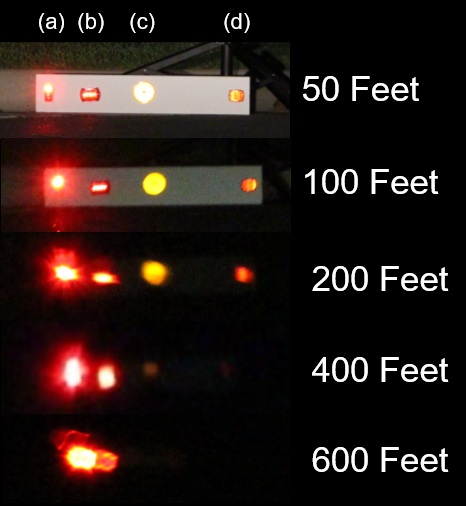
During the experiment, the bike reflector would virtually disappear even at short ranges with changes in headlamp orientation that resulted from minor changes in roadway grade (the street was not perfectly flat) or by turning the vehicle slightly. The height and position of the test devices were manually adjusted to compensate as much as possible, but the sensitivity to headlamp orientation was quite alarming.
The LED lamps were then switched to blinking mode, and video was recorded at 300 feet:
Lights versus Reflectors under Car Headlamps at 300 Feet
As shown, LED lamps are far more visible and conspicuous than reflectors at long distances. An LED lamp stands out better among other nearby vehicle lights (clutter) than does reflected power at long range. And given the video experiment, it’s no wonder why many cyclists think blinking LED lamps further increase distances for recognition as a bicyclist.
Optional: A Physics Lesson
At 500 feet, observed LED power can be 100x greater than observed reflector power. This is because reflected light coming off a bike reflector declines in power with distance by a different exponent than light coming from an LED lamp. If the range between the bicyclist and driver is R, then the LED light power reaching the driver declines proportional to 1/R^2. But for a reflector, the light power declines proportional to 1/R^4.
Reflectors have other weaknesses. Car headlights may not be on or working, and curves and hill crests affect beam orientation. As shown below, a bicyclist’s reflectors may not be illuminated until the last moment.
Disadvantages of Lights
Lights have their own issues as well. They require power, their batteries go dead, they are more expensive, and they can get stolen off of a parked bike. Bike lamps can also fail by breaking or popping open when hitting a pothole, or by shorting out in wet conditions. Unfortunately, failures are especially common with the least expensive, discount lamps that use brittle plastic for the housing or mount. Should a failure happen while you are riding, you may not even notice it, since the lamp is behind you. It’s important to use a rear reflector as an emergency backup just in case.
Bright LED tail lamps are available new for under $10. Unfortunately, some of these bargain lamps are of poor durability, and can snap off at the mounting bracket after one or two bumps. Others are cheap to buy but expensive to maintain because they use coin cell batteries. AAA batteries are more economical than coin cells over the life of the lamp, but rechargeable systems can be the best deal in the long run.
Bicycle headlamps are typically much brighter than tail lamps, because bike headlamps are normally used to illuminate the roadway itself, while tail lamps are just for visibility to others. The difference in power requirements means that tail lamps are usually less expensive than headlamps.
Enforcement and Education Concerns
BikeWalk NC does not take the idea of new bicycling regulations lightly. The cost and convenience of maintaining a rear lamp must be weighed against the safety benefits. Given the relative affordability of LED tail lamps and the high percentage of serious crashes involving unlighted cyclists hit from behind at night, it is the BikeWalk NC Board of Directors’ position that changing state law to require a rear lamp when bicycling at night will improve awareness of effective visibility equipment, increase bicyclist safety and save lives at a reasonable equipment cost.
Bikewalk NC recommends that such a legal change be accompanied by a comprehensive education campaign on night visibility for bicyclists using a variety of media. Enforcement actions should be focused on empowering bicyclists to get home safely through the use of lighting giveaways or by providing assistance at finding alternative transportation home. Funding needs to be secured to persist lighting giveaway programs, especially in low income areas. Sensitivity to minority perceptions of police activity will be vitally important in the execution of a safety campaign. Historically, police enforcement of bicycle lighting laws in North Carolina has most often been performed as a pretext to stop, question, and potentially search people, usually minorities. Pretextual stops of bicyclists riding at night without lights or without city registration have inflamed racial tensions in Tampa and other cities such as Miami, Fort Lauderdale and Washington DC. A change in the state’s bicycle lighting law must serve to protect minority bicyclists, not provide another way to victimize them.
BikeWalk NC Recommended Statute Change
20-129.(e) Lamps on Bicycles. – Every bicycle shall be equipped with a lighted lamp on the front thereof, visible under normal atmospheric conditions from a distance of at least 1000 feet in front of such bicycle, and shall also be equipped with a reflex mirror and lamp on the rear, exhibiting a red light visible under like conditions from a distance of at least 1000 feet to the rear of such bicycle, when used at night.
See Also
Requirements on Lighting and Reflectors of Bicycles, ANEC, 2012.
Bicycle Reflector Project, CPSC, 1996.
About Bicycle Reflectors, John Allen, 2001, 2014. http://www.bikexprt.com/bicycle/reflectors/
Why Reflectors Don’t Work, John Schubert, http://www.sheldonbrown.com/reflectors.html
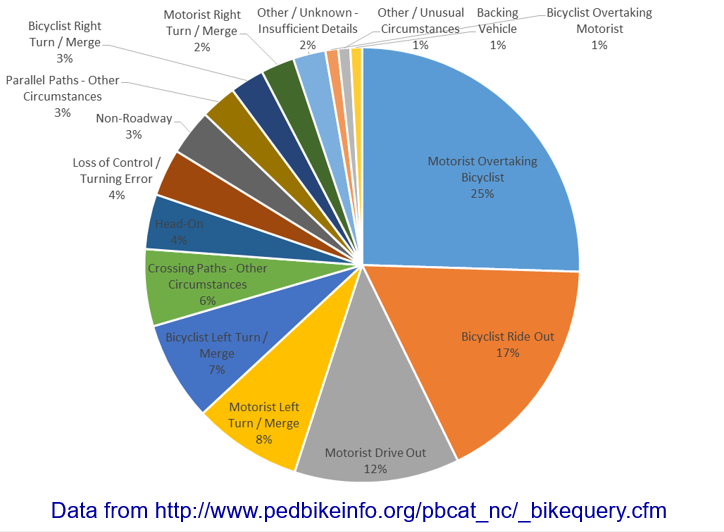
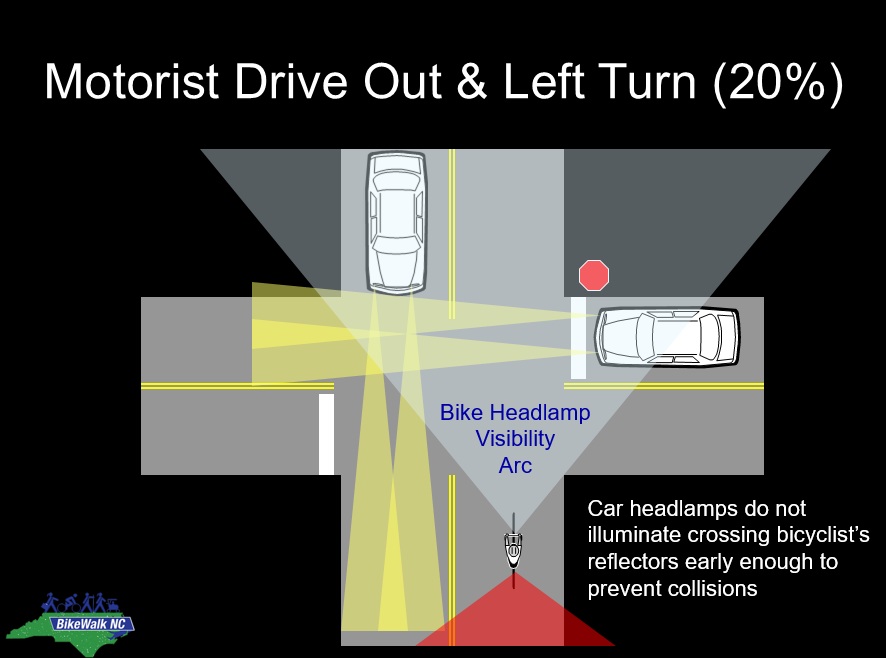
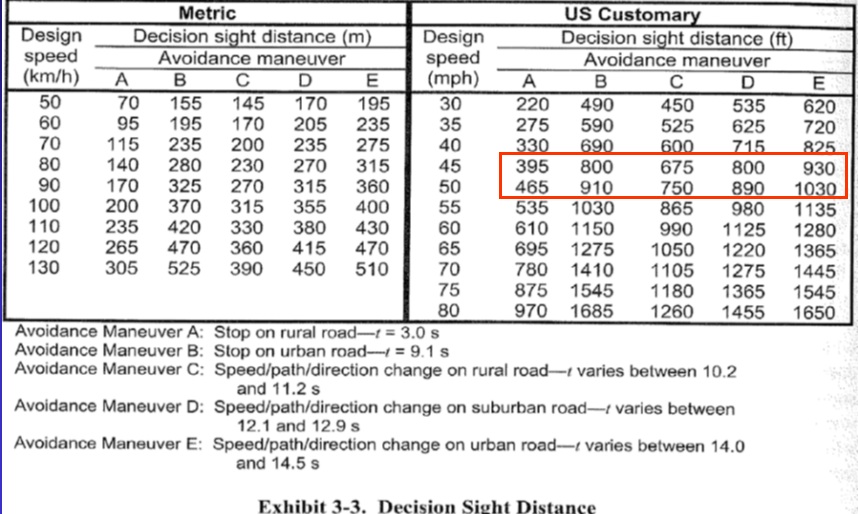

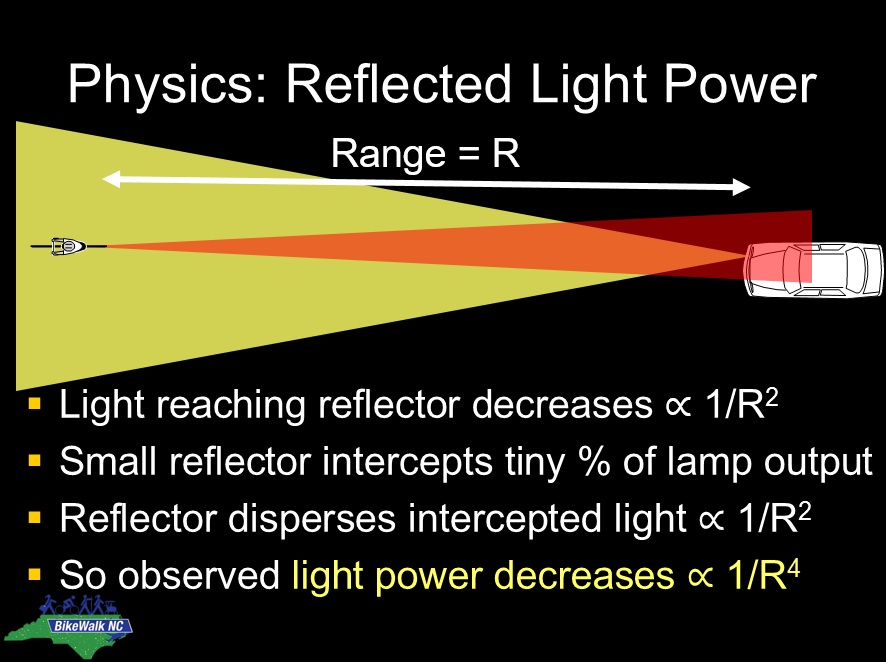
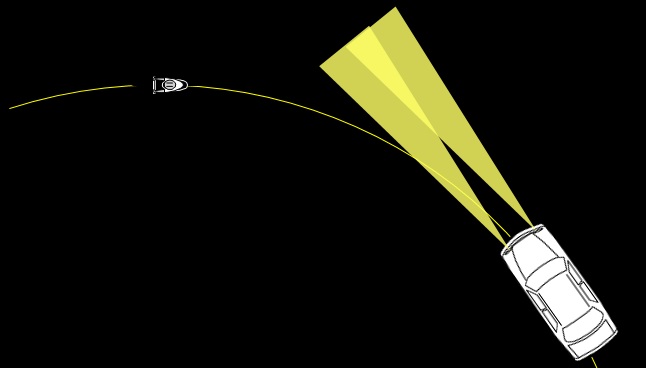
Ray says
The rule needs clarification as to where to mount the lights.
Are helmet-mounted lights sufficient? What about red blinkies attached to a backpack that is worn by the rider, or to a belt loop or clipped to a pocket? The rule says the headlight is to be mounted on the front of the bike. Again, what about mounting on the helmet?
As for rear lights, what constitutes the rear of the bike? The seat post? That’s the middle of the bike! What about the back of the helmet? Or, the back of a pannier? And some bikes don’t have anywhere to mount a rear blinky. The saddle might be on some type of cantilevered arm and the seat post is either non-existent or too oddly shaped for attaching the light. Some bikes with rear suspension don’t have “standard” seat stays to mount lights on, either.
Instead of saying where to mount the lights, the rule should say which way the lights should be directed. White lights directed ahead and red to the rear.
steven says
Helmet-mounted headlights are useful for seeing into sharp turns, but in traffic they pose a significant risk of blinding other drivers. LED tail lamps have a beam pattern that gives them maximum visibility range in a narrow angle. Proper aiming of the LED lamp is essential for effective visibility from long distances behind on high speed roads. For this reason, a rigid mount on the bicycle is greatly preferred over attachment to a helmet, backpack or other soft or moving surface. Different tail lamp manufacturers provide a variety of mounts for different bicycle components, including rear racks, stays, and saddle rails. Owners of bicycles with unusual designs may need to shop around for a commercially available lamp that provides an adequate mounting solution, or they may build their own.